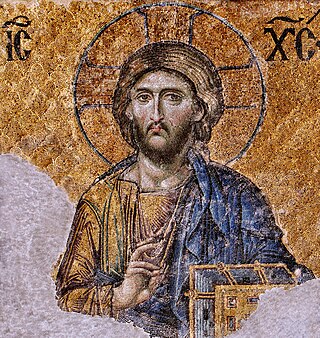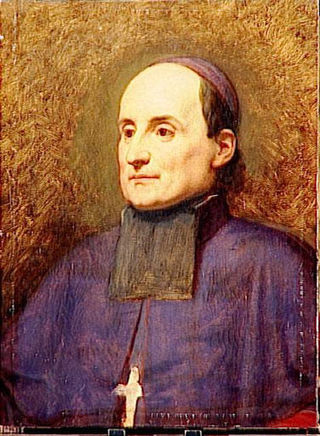The banns of marriage, commonly known simply as the "banns" or "bans", are the public announcement in a Christian parish church, or in the town council, of an impending marriage between two specified persons. It is commonly associated with the Catholic Church, the Church of Sweden (Lutheran), the Church of England (Anglican), and with other Christian denominations whose traditions are similar. In 1983, the Catholic Church removed the requirement for banns and left it to individual national bishops' conferences to decide whether to continue the practice, but in most Catholic countries the banns are still published.

Marriage in the Catholic Church, also known as holy matrimony, is the "covenant by which a man and woman establish between themselves a partnership of the whole of life and which is ordered by its nature to the good of the spouses and the procreation and education of offspring", and which "has been raised by Christ the Lord to the dignity of a sacrament between the baptised." Catholic matrimonial law, based on Roman law regarding its focus on marriage as a free mutual agreement or contract, became the basis for the marriage law of all European countries, at least up to the Reformation.
In Catholic canon law, an interdict is an ecclesiastical censure, or ban that prohibits certain persons or groups from participating in particular rites, or that the rites and services of the church are prohibited in certain territories for a limited or extended time.
Ne Temere was a decree issued in 1907 by the Roman Catholic Congregation of the Council regulating the canon law of the Church regarding marriage for practising Catholics. It is named for its opening words, which literally mean "lest rashly" in Latin.
In the canon law of the Catholic Church, a distinction is made between the internal forum, where an act of governance is made without publicity, and the external forum, where the act is public and verifiable. In canon law, internal forum, the realm of conscience, is contrasted with the external or outward forum; thus, a marriage might be null and void in the internal forum, but binding outwardly, i.e., in the external forum, for want of judicial proof to the contrary.
The Declaration of the Clergy of France was a four-article document of the 1681 assembly of the French clergy. Promulgated in 1682, it codified the principles of Gallicanism into a system for the first time into an official and definitive formula.

A defender of the bond is a Catholic Church official whose duty is to defend the marriage bond in the procedure prescribed for the hearing of matrimonial causes which involve the validity or nullity of a marriage already contracted. In current Canon Law the role is provided for in Book VII, Title 1, which deals with marriage processes.

A nomocanon is a collection of ecclesiastical law, consisting of the elements from both the civil law and the canon law. Nomocanons form part of the canon law of the Eastern Catholic Churches and of the Eastern Orthodox Church.
In the canon law of the Catholic Church, an impediment is a legal obstacle that prevents a sacrament from being performed either validly or licitly or both. The term is used most frequently in relationship to the sacraments of Marriage and Holy Orders. Some canonical impediments can be dispensed by the competent authority as defined in Catholic canon law.
Tametsi is the legislation of the Catholic Church which was in force from 1563 until Easter 1908 concerning clandestine marriage. It was named, as is customary in Latin Rite ecclesiastical documents, for the first word of the document that contained it, Chapter 1, Session 24 of the Council of Trent. It added the impediment of clandestinity and established the canonical form of marriage for validity in the regions in which it was promulgated.

Elzéar of Sabran, T.O.S.F., Baron of Ansouis, Count of Ariano, was born in the castle of Saint-Jean-de-Robians, near Cabrières-d'Aigues in Provence, southern France, in 1285. He died in Paris, France, on September 27, 1323. He was a tertiary of the Franciscan Order as well as a ruler, diplomat and military leader. He was recognised as a saint in the Catholic Church.
The Provincial Councils of Baltimore were councils of Roman Catholic bishops that set the pattern for Catholic organisation in the United States of America. They were seen as having a unique importance for the Church in the United States, inasmuch as the earlier ones legislated for practically the whole territory of the Republic, and furnished moreover a norm for all the later Plenary Councils of Baltimore covering the whole country. This article touches upon only those parts of the canonical legislation which may seem in any way to individualize the discipline of the Church in the United States or depict the peculiar needs and difficulties of its nascent period.
Ecclesiastical letters are publications or announcements of the organs of Roman Catholic ecclesiastical authority, e.g. the synods, but more particularly of pope and bishops, addressed to the faithful in the form of letters.

Marie-Dominique-Auguste Sibour was the French Catholic Archbishop of Paris from 1848 to 1857.

Augustine Francis Hewit was an American Redemptorist priest, and second Superior General of the Paulist Fathers.
A filial church, in the Roman Catholic Church, is a church to which is annexed the cure of souls, but which remains dependent on another church. The term comes from the Latin filialis, from filia, “daughter”.
Altarage is a term once commonly used in an ecclesiastical context to signify the revenue reserved for the chaplain in contradistinction to the income of the parish priest — it came to indicate the funds received by a priest from the laity when discharging a particular function for them, e.g., marriages, baptisms, and funerals. The term is largely obsolete, having been replaced by the more specific honorarium, stipend, or stole-fee.
Immaculate Heart of Mary Church, is a Catholic parish church in Cleveland, Ohio and part of the Diocese of Cleveland. It is a located on Lansing Ave. near East 66th St., in a part of the South Broadway neighborhood previously known as Warszawa, also referred to today as Slavic Village. Both the church and the area are GNIS named features. The church is in the neighborhood of, but not within, the area listed as Warszawa Neighborhood District on the National Register of Historic Places. The church, school, rectory, and convent buildings are listed together as a Cleveland Designated Landmark.
The jurisprudence of Catholic canon law is the complex of legal theory, traditions, and interpretative principles of Catholic canon law. In the Latin Church, the jurisprudence of canon law was founded by Gratian in the 1140s with his Decretum. In the Eastern Catholic canon law of the Eastern Catholic Churches, Photios holds a place similar to that of Gratian for the West.

A religious sister in the Catholic Church is a woman who has taken public vows in a religious institute dedicated to apostolic works, as distinguished from a nun who lives a cloistered monastic life dedicated to prayer. Both nuns and sisters use the term "sister" as a form of address.






